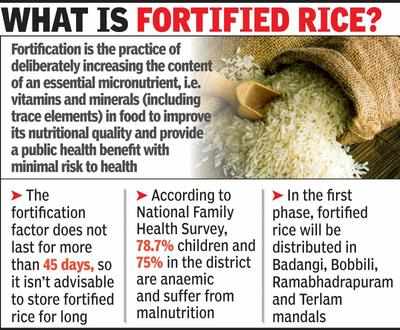Context
-
The Union Cabinet recently approved a scheme to distribute fortified rice under government programmes.
What is rice fortification?
- The Food Safety and Standards Authority of India (FSSAI) defines fortification as “deliberately increasing the content of essential micronutrients in a food so as to improve the nutritional quality of food and to provide public health benefit with minimal risk to health”.

Credit: Times of India - Various technologies are available to add micronutrients to regular rice, such as coating, dusting, and ‘extrusion’. The last mentioned involves the production of fortified rice kernels (FRKs) from a mixture using an ‘extruder’ machine. It is considered to be the best technology for India.
- The fortified rice kernels are blended with regular rice to produce fortified rice.
How does the extrusion technology to produce FRK work?
- Dry rice flour is mixed with a premix of micronutrients, and water is added to this mixture. The mixture is passed through a twin-screw extruder with heating zones, which produces kernels similar in shape and size to rice. These kernels are dried, cooled, and packaged for use.
- FRK has a shelf life of at least 12 months.
- As per guidelines issued by the Ministry of Consumer Affairs, Food and Public Distribution, the shape and size of the fortified rice kernel should “resemble the normal milled rice as closely as possible”.
- According to the guidelines, the length and breadth of the grain should be 5 mm and 2.2 mm respectively.
But why does rice have to be fortified in the first place?
- India has very high levels of malnutrition among women and children. According to the Food Ministry, every second woman in the country is anaemic and every third child is stunted.
- Fortification of food is considered to be one of the most suitable methods to combat malnutrition.
- Rice is one of India’s staple foods, consumed by about two-thirds of the population.
- Per capita rice consumption in India is 6.8 kg per month.
- Therefore, fortifying rice with micronutrients is an option to supplement the diet of the poor.
What are the standards for fortification?
- Under the Ministry’s guidelines, 10 g of FRK must be blended with 1 kg of regular rice.
- According to FSSAI norms, 1 kg of fortified rice will contain the following:
- iron (28 mg-42.5 mg),
- folic acid (75-125 microgram), and
- vitamin B-12 (0.75-1.25 microgram).
- Rice may also be fortified with
- zinc (10 mg-15 mg),
- vitamin A (500-750 microgram RE),
- vitamin B-1 (1 mg-1.5 mg),
- vitamin B-2 (1.25 mg-1.75 mg),
- vitamin B-3 (12.5 mg-20 mg) and
- vitamin B-6 (1.5 mg-2.5 mg) per kg.
Does fortified rice have to be cooked differently?
- The cooking of fortified rice does not require any special procedure.
- The rice needs to be cleaned and washed in the normal way before cooking.
- After cooking, fortified rice retains the same physical properties and micronutrient levels as it had before cooking.
What is India’s capacity for fortification?
- At the time of the PM’s announcement last year, nearly 2,700 rice mills had installed blending units for production of fortified rice, and India’s blending capacity stood at 13.67 lakh tonnes in 14 key states, according to figures provided by the Ministry.
- FRK production had increased rapidly from 7,250 tonnes to 60,000 tonnes within 2 years.
How can a beneficiary distinguish between fortified rice and regular rice?
- Fortified rice will be packed in jute bags with the logo (‘+F’) and the line “Fortified with Iron, Folic Acid, and Vitamin B12”.
Reference:
https://indianexpress.com/article/explained/what-is-fortified-rice-how-is-it-prepared-7860432/
Visit Abhiyan PEDIA (One of the Most Followed / Recommended) for UPSC Revisions: Click Here
IAS Abhiyan is now on Telegram: Click on the Below link to Join our Channels to stay Updated
IAS Abhiyan Official: Click Here to Join
For UPSC Mains Value Edition (Facts, Quotes, Best Practices, Case Studies): Click Here to Join
